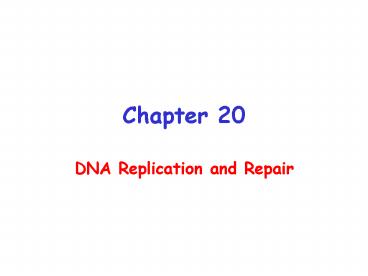DNA Replication and Repair PowerPoint PPT Presentation
1 / 32
Title: DNA Replication and Repair
1
Chapter 20
- DNA Replication and Repair
2
Watson and Crick Predicted Semi-conservative
Replication of DNA
- Watson and Crick "It has not escaped our notice
that the specific (base) pairing we have
postulated immediately suggests a possible
copying mechanism for the genetic material." - The mechanism Strand separation, followed by
copying of each strand. - Each separated strand acts as a template for the
synthesis of a new complementary strand.
3
(No Transcript)
4
The Semiconservative Model
- Matthew Meselson and Franklin Stahl tested
semi-conservative model - Template DNA labeled with 15N nucleotides. (more
dense than normal DNA) - Fed 14N nucleotides. (newly synthesized DNA was
less dense than template) - Isolated DNA at different times and fractionated
DNA on a density gradient - denser/heavier DNA found lower in the gradient.
- Less dense/lighter DNA found higher in gradient.
5
(No Transcript)
6
Replication is bidirectional
7
- E. coli genome size 4.6 X 106 bp
- Bacteria have circular chromosome with single
origin of replication. - Replication rate is 1000 base pairs per second.
- Duplicate chromosome in 38 minutes.
8
- Eukaryotes have larger genomes 3 X 109 bps
- Rate of Eukaryote chromosome replication is
slower - But because eukaryote chromosomes have multiple
origins of replication, it takes about the same
amount of time to replicate complete genome.
9
DNA Replication is Semidiscontinuous
10
Okazaki Fragments
11
The Enzymology of DNA Replication
- If Watson and Crick were right, then there should
be an enzyme that makes DNA copies from a DNA
template - In 1957, Arthur Kornberg and colleagues
demonstrated the existence of a DNA polymerase - - Three DNA polymerases in E. coli
- DNA polymerase I DNA repair and participates in
synthesis of lagging strand - DNA polymerase II DNA repair
- DNA polymerase III major polymerase involved in
DNA replication.
12
(No Transcript)
13
DNA Polymerase III is a Multisubunit Enzyme
14
DNA Polymerase III Subunit Organization
15
DNA Replication is a Processive Process.
- DNA Polymerase remains bound to the replication
fork. - Dimer of b-subunit forms ring structure around
the growing DNA chains.
16
DNA Polymerase also has proof reading function
- The polymerization reactions have an error rate
of 1 mistake for every 100,000 base pairs
incorporated (1 X 10-5 errors per base) - DNA polymerase has 3 to 5 exonuclease function
(epsilon-subunit) that recognizes base pair
mismatches and removes them. - Therefore proof reading function helps eliminate
errors which could lead to detrimental mutations. - However proof reading exonuclease has error rate
of 1 mistake for every 100 base pairs (1 X 10-2
errors per base) - Overall error rate is 1 X 10-7 errors per base.
17
Stages of DNA Replication
- Initiation
- Elongation
- Termination
18
Initiation of Replication
- in E. coli
- The replisome consists of DNA-unwinding
proteins, the priming complex (primosome) and two
equivalents of DNA - polymerase III holoenzyme
- Initiation DnaA protein binds to repeats in ori,
initiating strand separation and DnaB, a helicase
delivered by DnaC, further unwinds. Primase then
binds and constructs the RNA primer
19
(No Transcript)
20
Elongation Stage of Replication
- Elongation involves DnaB helicase unwinding, SSB
binding to keep strands separated. - Primase Complex Synthesizes short RNA primers.
- DNA polymerase grinding away on both strands
- Topoisomerase II (DNA gyrase) relieves
supercoiling that remains
21
(No Transcript)
22
(No Transcript)
23
DNA Polymerase I/ Ligase Required to Join Okazaki
Fragments
- DNA polymerase I has 5 to 3 exonuclease
activity that removes RNA primer. - Also has 5 to 3 DNA polymerase activity to fill
in the gap. (proofreading 3-5 exonuclease
activity) - Ligase connects loose ends. Used NAD in
phosphoryltransfer reaction, not a redox reaction
(Page 643)
24
(No Transcript)
25
Termination of Replication
- Termination occurs at ter region of E. coli
chromosome. - ter region rich in Gs and Ts, signals the end of
replication. - Terminator utilization substance (Tus) binds to
ter region. - Tus prevents replication fork from passing by
inhibiting helicase activity.
26
DNA Replication in Eukaryotes
- Occurs similarly to what occurs in prokaryotes.
- Multiple origins of replication
- Replication is slower than in prokaryotes.
- 5 different DNA polymerases in Eukaryotes.
27
Eukaryotic DNA Polymerases
- Alpha Primer synthesis and DNA repair
- Beta DNA repair
- Gamma Mitochondrial DNA replication
- Delta Leading and lagging strand synthesis, and
DNA repair - Epsilon Repair and gap filling on lagging
strand.
28
PCNA analogous to E. coli b-subunit of E. coli
DNA polymerase
- Proliferating cell nuclear antigen
- Trimeric protein
- Sliding clamp structure binds to newly
synthesized DNA strand
29
DNA Repair
- A fundamental difference from RNA, protein,
lipid, etc. - All these others can be replaced, but DNA must be
preserved - Cells require a means for repair of missing,
altered or incorrect bases, bulges due to
insertion or deletion, UV-induced pyrimidine
dimers, strand breaks or cross-links - Two principal mechanisms methods for reversing
chemical damage and excision repair.
30
Repair of UV Induced Thymine Dimers
31
- Excision-repair systems scan DNA duplexes for
mismatched bases, excise the mispaired region and
replace it
32
Repair of damage resulting from the deamination
of cytosine
- Deamination of cytosine to uracil is one of most
common forms of DNA damage - DNA glycosylases cleave bases at N-glycosidic
linkages. Leaving sugar-phosphate backbone. - Endonuclease identifies abscent base and sugar
phosphate. - Gap then filled in by DNA polymerase and ligase.

